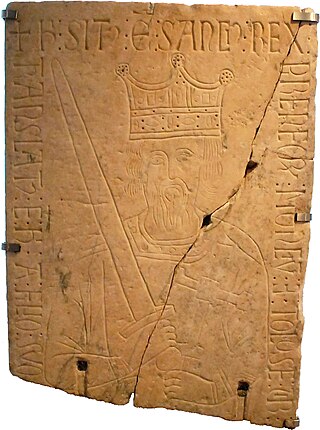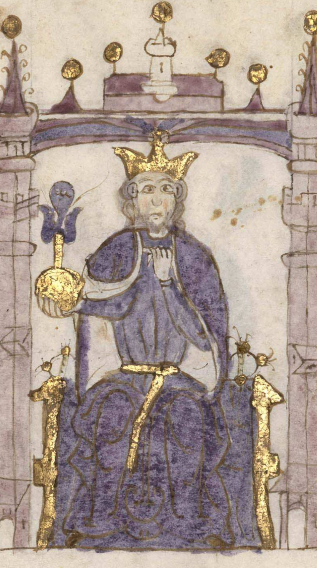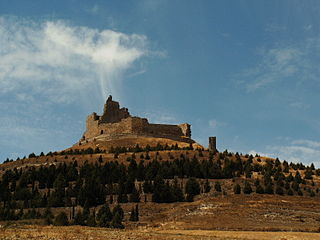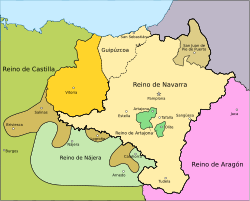
Sancho Garcés III, also known as Sancho the Great, was the King of Pamplona from 1004 until his death in 1035. He also ruled the County of Aragon and by marriage the counties of Castile, Álava and Monzón. He later added the counties of Sobrarbe (1015), Ribagorza (1018) and Cea (1030), and would intervene in the Kingdom of León, taking its eponymous capital city in 1034.

Nájera is a small town, former bishopric and now Latin Catholic titular see, former capital of the Kingdom of Navarre, located in the "Rioja Alta" region of La Rioja, northern Spain, on the river Najerilla. Nájera is a stopping point on the French Way the most popular path on the Way of St James.

The Kingdom of Navarre, originally the Kingdom of Pamplona, was a Basque kingdom that occupied lands on both sides of the western Pyrenees, with its northernmost areas originally reaching the Atlantic Ocean, between present-day Spain and France.

Sancho Garcés VI, called the Wise was King of Navarre from 1150 until his death in 1194. He was the first monarch to officially drop the title of King of Pamplona in favour of King of Navarre, thus changing the designation of his kingdom. Sancho Garcés was responsible for bringing his kingdom into the political orbit of Europe. He was the eldest son of García Ramírez, the Restorer and Margaret of L'Aigle.

García Ramírez, sometimes García IV, V, VI or VII, called the Restorer, was the King of Navarre (Pamplona) from 1134. The election of García Ramírez restored the independence of the Navarrese kingdom after 58 years of political union with the Kingdom of Aragon. After some initial conflict he would align himself with king Alfonso VII of León and Castile, and as his ally take part in the Reconquista.
García Sánchez I, was the king of Pamplona from 925 until his death in 970. He was the second king of the Jiménez dynasty, succeeding his father when he was merely six years old.
Sancho Garcés I, also known as Sancho I, was king of Pamplona from 905 until 925. He was the son of García Jiménez and was the first king of Pamplona of the Jiménez dynasty. Sancho I was the feudal ruler of the Onsella valley, and expanded his power to all the neighboring territories. He was chosen to replace Fortún Garcés by the Pamplonese nobility in 905.

García Sánchez II, was King of Pamplona and Count of Aragon from 994 until his death c. 1000. He was the eldest son of Sancho II of Pamplona and Urraca Fernández and the second Pamplonese monarch to also hold the title of count of Aragon. Modern historians refer to him as the Tremulous, though this appellation likely originally applied to his grandfather, García Sánchez I of Pamplona.

García Sánchez III, nicknamed García from Nájera was King of Pamplona from 1034 until his death. He was also Count of Álava and had under his personal control part of the County of Castile. As the eldest son of Sancho III he inherited the dynastic rights over the crown of Pamplona, becoming feudal overlord over two of his brothers: Ramiro, who was given lands that would serve as the basis for the Kingdom of Aragón; and Gonzalo, who received the counties of Sobrarbe and Ribagorza. Likewise, he had some claim to suzerainty over his brother Ferdinand, who under their father had served as Count of Castile, nominally subject to the Kingdom of León but brought under the personal control of Sancho III.
Sancho Garcés IV, nicknamed Sancho of Peñalén was King of Pamplona from 1054 until his death. He was the eldest son of García Sánchez III and his wife, Stephanie, and was crowned king of Pamplona after his father was killed during the Battle of Atapuerca.
Muniadona of Castile, also called Mayor or Munia, was Queen of Pamplona by her marriage with King Sancho Garcés III, who later added to his domains the Counties of Ribagorza (1017) and Castile (1028) using her dynastic rights to these territories.

Imperator totius Hispaniae is a Latin title meaning "Emperor of All Spain". In Spain in the Middle Ages, the title "emperor" was used under a variety of circumstances from the ninth century onwards, but its usage peaked, as a formal and practical title, between 1086 and 1157. It was primarily used by the kings of León and Castile, but it also found currency in the Kingdom of Navarre and was employed by the counts of Castile and at least one duke of Galicia. It signalled at various points the king's equality with the rulers of the Byzantine Empire and Holy Roman Empire, his rule by conquest or military superiority, his rule over several ethnic or religious groups, and his claim to suzerainty over the other kings of the peninsula, both Christian and Muslim. The use of the imperial title received scant recognition outside of Spain and it had become largely forgotten by the thirteenth century.

The Jiménez dynasty, alternatively called the Jimena, the Sancha, the Banu Sancho, the Abarca or the Banu Abarca, was a medieval ruling family which, beginning in the 9th century, eventually grew to control the royal houses of several kingdoms on the Iberian Peninsula during the 11th and 12th centuries, namely the Kingdoms of Navarre, Aragon, Castile, León and Galicia as well as of other territories in the South of France. The family played a major role in the Reconquista, expanding the territory under the direct control of the Christian states as well as subjecting neighboring Muslim taifas to vassalage. Each of the Jiménez royal lines ultimately went extinct in the male line in the 12th or 13th century.

Lope Íñiguez (c. 1050 – 1093) succeeded his father Íñigo López to become the second Lord of Biscay in 1076.
García Ordóñez, called de Nájera or de Cabra and Crispus or el Crespo de Grañón in the epic literature, was a Castilian magnate who ruled the Rioja, with his seat at Nájera, from 1080 until his death. He is famous in literature as the rival of Rodrigo Díaz de Vivar, the Cid, whose high position at court he took over after the Cid's exile in 1080. He was one of the most important military leaders and territorial governors under Alfonso VI, and was entrusted with military tutorship of the king's heir, Sancho Alfónsez, with whom he died on the field of battle at Uclés.
Ramiro Garcés was the second son of king García Sánchez III of Pamplona and queen Stephania. He was a powerful nobleman in the region around Nájera and Calahorra and a major figure at the courts of both Navarre and Castile. He was ambushed and killed while trying to take possession of the castle of Rueda de Jalón during the Reconquista.
Fortún Galíndez was a powerful nobleman in the Kingdom of Navarre in the tenth century. He is the only recorded Navarrese of that time to bear the title dux (duke). He was entrusted by Sancho I with the newly conquered territory of the Rioja Alta around Nájera. In 924 he held the title senior in Naiera ; from 942 he was praefectus in Naiera ; and from 950 he was titled dux. He appears to have governed the Rioja with quasi-regal authority, part of a Navarrese experiment in creating a new kingdom, which would be the Kingdom of Viguera.
Sancho Garcés was an illegitimate son of King García Sánchez III of Pamplona and first cousin of King Alfonso VI of León. Lord of Uncastillo and Sangüesa, he was the father of Ramiro Sánchez whose son García Ramírez was the first of a new dynasty of Navarrese monarchs.

Gutierre Fernández de Castro was a nobleman and military commander from the Kingdom of Castile. His career in royal service corresponds exactly with the reigns of Alfonso VII (1126–57) and his son Sancho III (1157–58). He served Alfonso as a courtier after 1134 and as majordomo (1135–38). He was the guardian and tutor the young Sancho III from 1145. Before his death he was also briefly the guardian of Sancho's infant son, Alfonso VIII.
Blasco Gardéliz de Ezcároz was the bishop of Pamplona from 1068 until 1078 or 1079. He was the prior of the monastery of San Salvador de Leire from 1054 until his election as bishop. Although the bishops of Pamplona had held the abbacy of Leire since the time of Sancho the Great, this tradition was broken when Blasco became bishop. The monastery went instead to Fortunio, the bishop of Álava, in 1068.























